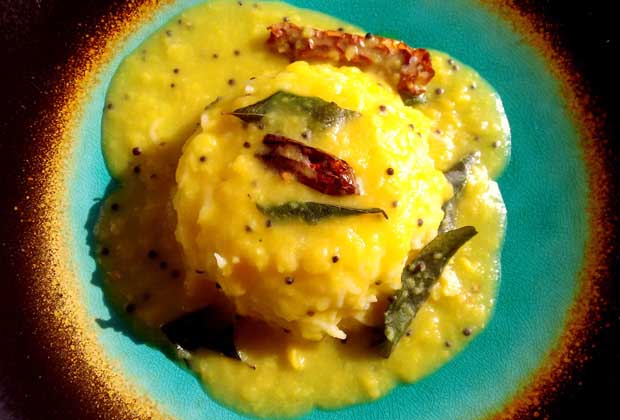The secret of the Konkani Dali Thoy
- By Shanti PetiwalaLoading...
- | 8 July 2015 12:17 PM IST
 X
X
 Hot dali thoy is enjoyed best with mashed potatoes. Photo: Shanti Petiwala
Hot dali thoy is enjoyed best with mashed potatoes. Photo: Shanti Petiwala
Friday mornings for me as a kid raised in the Gulf were as exciting as it could be. It was the weekend – and in my opinion (and the rest of my generations) – the one day we could sleep in late.
But, unfortunately, my parents didn’t hold the same beliefs and waking us up on weekends was quite an ordeal. My motivation was the 12 p.m. 'Khana Khazana' show that my father and I would religiously watch every Friday.
We would be hooked to the TV watching Sanjeev Kapoor casually chopping up vegetables, stirring a thing or two in the pan, and then finally garnishing the dish with flair. And then, my hands would work as I would take down the recipe of whatever he had made as fast as I could with my parents adding in whatever I would miss out.
Many a delicious experiment of mine has been the result of these weekend weekly shows that I would watch with my father.
I’ve always felt that my passion for cooking came from him. My mother is a brilliant cook, no doubt, (most of my initial knowledge of baking, cooking, ingredients and flavour combinations have come from her), but it isn’t her passion.
My father, on the other hand, made the most amazing dosas, Chinese food, a brilliant coconut chutney that still reminds me of school mornings, French toast and the best curd ever! In our house, he was also the 'phanna’ master.
‘Phanna’ in Konkani is tempering and, in my opinion, the basis of any dish. My father’s ‘phanna’ for the Dali Thoy – a quintessential amchi dish that will be found in any amchi house on a regular day – was epic.
Dali Thoy is a simple preparation of tuvar dal with a deceivingly simple tempering that becomes the defining flavour of the dish. Whenever possible, the dal would be prepared beforehand and all my father was needed for was the tempering.
The standing joke in the house was that the Dali Thoy alone was responsible for the highest use of mustard seeds in the house!
I would stand beside my dad, keenly watching him and observing his actions because I desperately wanted to replicate what he did. It is no rocket science – the right 'phanna' is about the temperature of the oil and the proportion and sequence of ingredients used.
The right steps and ingredients together bring about a heady, almost sweet aroma that fills the kitchen and infuses into the dal. After all, the aroma is the key of any tempering.
To, this day, whenever I visit my mum, I am responsible for the tempering for the dal, because beyond taste, that is a reminder of a time long gone.
Recipe for Dali Thoy
Ingredients
1 cup tuvar dal (split pigeon pea)
¼ tsp turmeric
1 green chilli
3 cups of water
Salt to taste
2 tbsp oil
½ tsp mustard seeds
2 Byadgi chillies broken into half (you can use other red chillies – I wouldn’t prefer the Kashmiri variety)
A handful of curry leaves
A generous pinch of hing or asafoetida
Method:
1. Boil/pressure cook the dal with the turmeric, green chilli and water till soft and mashable. I usually wait for four whistles on the pressure cooker.
2. Once it's done, put it back on the heat directly, and add salt to taste. Simmer on the gas.
3. In a tempering pan/bowl, heat the oil. Once it is shimmery, add the mustard seeds. They must crackle immediately.
4. Once they are 90% white/crackled, put in the red chillies and stir slightly till the aroma of both waft into the air.
5. Now, add the curry leaves and stir once, before putting in the asaoetida. Quickly stir the tempering into the simmering dal and cover to let the flavour infuse.
I like to serve this hot with an upkari (vegetable stir-fry amchi style) and my dad’s mashed potatoes (more on that later).
A writer and editor by profession, my passion lies in food and exploring its horizons. It has always been my comfort, challenge and satisfaction. I absolutely love ingredients, which have been the muse to my writing and inspiration to my cooking. Through my blog Riot of Flavours, I talk about my world of cooking and eating and seek to promote my native cuisine the Chitrapur Saraswat Cuisine from Karnataka.
Follow Shanti on Twitter and Instagram @riotofflavours



